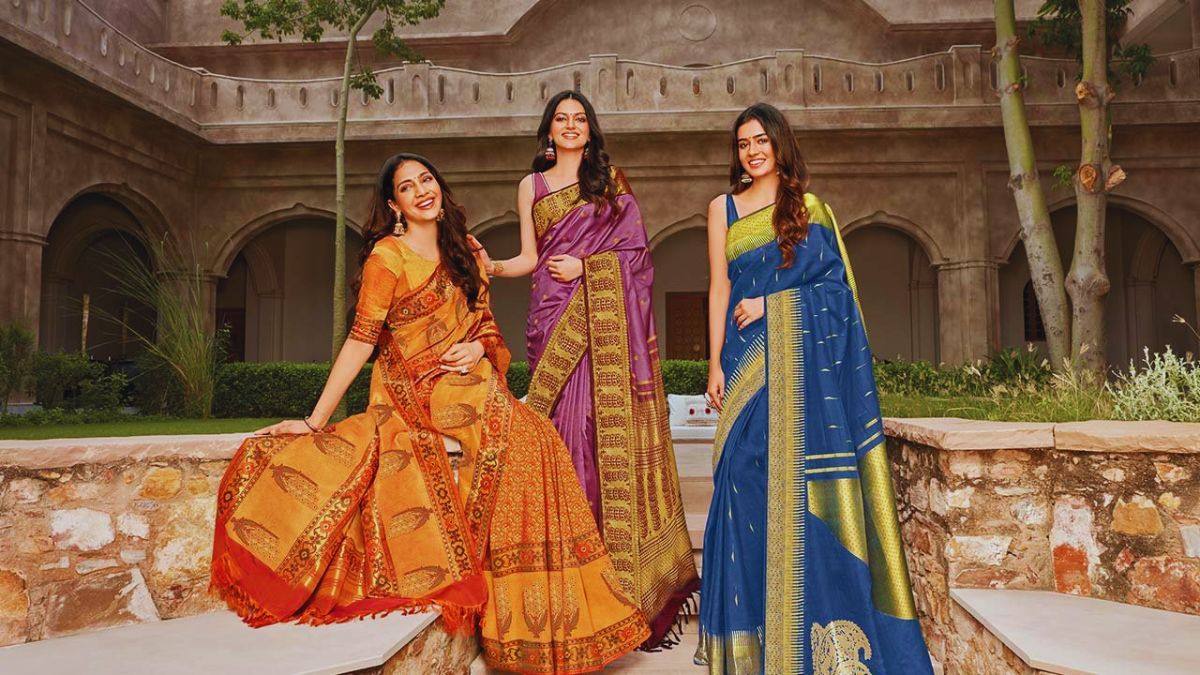The Indian saree, with its vibrant colours, intricate designs, and flowing elegance, is more than just a garment; it’s a timeless tapestry of history, tradition, and cultural significance. Its history spans millennia, beginning with a simple drape worn by women in the Indus Valley Civilization and ending with a presence in modern fashion and international cultural events.
This captivating attire not only has a special place in Indian society, but it also serves as a bridge, fostering connections and celebrating India’s rich heritage across borders. The saree exemplifies the timeless elegance woven into the fabric of India. An initiative like the Anant Sutra, which unveils its visual spectacle on Republic Day, highlights not only the beauty of the saree but also its deep connection to the nation’s rich tapestry.
On Republic Day, Anant Sutra unveiled a visually stunning tribute to the sari, featuring nearly 1,900 sarees and drapes from all over India along the Kartavya Path.
This installation, which celebrated heritage and diversity, echoed the sentiment that the sari is more than just a piece of clothing; it is a timeless gift to the world of fashion. The word “sari,” which comes from the depths of Sanskrit, simply means “strip of cloth.”
However, within the folds of these six to nine yards, Indian women and a few men discover far more than just a piece of fabric. The saree is a symbol of national pride, an ambassador of both traditional and modern design, and a reflection of the many differences that distinguish each of India’s states and union territories. Each sari has a unique story woven into the threads, reflecting the society and people around it.
Whether it’s the intricate weave of a Banarasi silk saree or Manipur’s ‘Moirang Phee’, weavers in Varanasi, the heart of craftsmanship, lean over old-school wooden looms—a testament to tradition meeting timeless elegance.
In contrast, tropical Kerala’s predominantly white sett mundu saris reflect styles that predate 19th-century industrialization. West Bengal has Balchuri saris with trim inspired by designs found on the walls of the region’s ancient terracotta temples, demonstrating the fusion of art, history, and fashion.
Saris are more than just garments; they are vessels of nostalgia and memory. Each sari elicits emotions, with certain pieces associated with specific moments, events, or cherished memories. The touch of a particular fabric can transport one to the warmth of their grandmother’s embrace or the joy of a festive celebration.
The saree is commonly regarded as women’s clothing. The saree’s impact on the global stage is long-lasting, much like the pallu that gracefully trails behind. Men and women are equally related to sarees.
A child in Indian society is raised by his mother’s anchal and learns to see the world by clinging to his mother’s and grandmother’s pallu from a young age. Saree’s Aanchal becomes his emotional support system, something he will require throughout his life. It gives him strength and creates an unbreakable bond with the clothing.
Draping a saree is an art, and there are over a hundred different ways to do it, depending on the region, fabric, length, and the wearer’s daily activities.
The saree is more than just a garment; it is a cultural symbol, a living legacy that evolves over time while remaining grounded in tradition. The saree continues to flutter through the streets of Mumbai, grace Bollywood screens, and adorn generations of Rajasthanis, serving as an ever-present symbol of elegance and cultural identity. The saree is more than just a piece of clothing; it represents resilience, adaptability, and the enduring spirit of India’s rich culture.
Each sari, a form of cultural poetry, tells a story about society and the people who created it.
From intricately woven Benarasi silk on jacquard pit looms to Manipur’s cotton-based ‘Moirang Phee’ crafted on throw and shuttle looms, each variation has its own distinct characteristics while remaining culturally significant. In a country where there are over a hundred ways to drape a sari, depending on region, fabric, length, and the wearer’s activities, these garments weave their way through the tapestry of Indian culture.
From the bustling streets of Mumbai, where women on bicycles showcase a riot of colours, to the glitzy world of Bollywood, where actresses adorn themselves in elaborate drapes, and the vibrant family gatherings in Rajasthan, where generations are united through the common thread of the sari, the sari is not limited by nationality or belief; it is a universal symbol of elegance that connects the past, present, tradition, and modernity.
Visitors who are captivated by the vibrancy and mythology of saris can take home a piece of this cultural tapestry.
It demonstrates the sari’s universal appeal as a garment that crosses borders and tells stories of heritage, pride, and timeless elegance. The saree, with its vibrant colours and flowing elegance, transcends borders and captures hearts all over the world.
Not only is it India’s national dress, but it is also worn in Sri Lanka and Bangladesh. From Priyanka Chopra’s red carpet moments to Deepika Padukone’s Cannes appearances, iconic women have made their mark on the global fashion scene, demonstrating the saree’s timeless beauty and cultural significance.
It is a whisper of heritage, a canvas for self-expression, and a symbol of empowerment that will forever enchant the world with its magic.
As we cherish and celebrate this iconic garment, keep in mind that each drape tells a story of identity, tradition, and the enduring spirit of our land.
